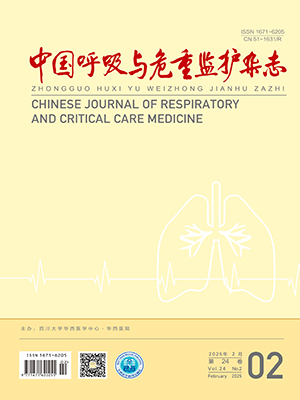| 1. |
Wunsch H, Guerra C, Barnato AE, et al. Three-year outcomes for medicare beneficiaries who survive intensive care. JAMA, 2010, 303(9): 849-856.
|
| 2. |
魏春莲, 廖莲清, 刘沛仪, 等. ICU 转出过渡护理在重度 COPD 患者转至呼吸内科中的应用效果. 护士进修杂志, 2015, 30(12): 1103-1105.
|
| 3. |
庄一渝, 韦秀霞, 彭剑英, 等. ICU 过渡期护理临床实践与研究进展. 中华护理杂志, 2016, 51(2): 211-215.
|
| 4. |
Needham DM, Davidson J, Cohen H, et al. Improving long-term outcomes after discharge from intensive care unit: report from a stakeholders' conference. Crit Care Med, 2012, 40(2): 502-509.
|
| 5. |
Elliott D, Davidson JE, Harvey MA, et al. Exploring the scope of post-intensive care syndrome therapy and care: engagement of non-critical care providers and survivors in a second stakeholders meeting. Crit Care Med, 2014, 42(12): 2518-2526.
|
| 6. |
Locke M, Eccleston S, Ryan CN, et al. Developing a diary program to minimize patient and family post-intensive care syndrome. AACN Adv Crit Care, 2016, 27(2): 212-220.
|
| 7. |
叶小健, 庄一渝, 陈香萍, 等. ICU 后综合征的干预研究现状. 中华护理杂志, 2015, 50(11): 1369-1374.
|
| 8. |
韦秀霞, 张秀伟, 彭剑英, 等. 国外 ICU 后综合征的研究现状. 中华护理杂志, 2016, 51(1): 84-89.
|
| 9. |
Hopkins RO, Mitchell L, Thomsen GE, et al. Implementing a mobility program to minimize post-intensive care syndrome. AACN Adv Crit Care, 2016, 27(2): 187-203.
|
| 10. |
裴倩倩, 王旭东, 李晶, 等. 多学科合作式过渡期护理在ICU后综合征预防中的应用. 护理实践与研究, 2017, 14(5): 36-37.
|
| 11. |
敖漫, 敖薪. ICU 后综合征评估工具的研究进展. 护理管理杂志, 2018, 18(2): 107-111.
|
| 12. |
Ely EW, Inouye SK, Bernard GR, et al. Delirium in mechanically ventilated patients: Validity and reliability of the confusion assessment method for the intensive care unit (CAM-ICU). JAMA, 2001, 286(21): 2703-2710.
|
| 13. |
周小炫. 中文版简易智能精神状态检查量表在脑卒中患者中的信效度初步研究[D]. 福建: 福建中医药大学, 2015: 1-32.
|
| 14. |
孙军连. 医患焦虑抑郁状况的评价及其对医院满意度的影响[D]. 山西: 山西医科大学第三医院, 2011: 1-5.
|
| 15. |
路桃影, 李艳, 夏萍, 等. 匹兹堡睡眠质量指数的信度及效度分析. 重庆医学, 2014, 43(3): 260-263.
|
| 16. |
王天芳, 张翠珍, 刘雁峰, 等. 慢性疲劳综合征病人的疲劳、抑郁、焦虑及生活事件的特点及其间相关性分析. 中国行为医学科学杂志, 2000, 9(2): 84-86.
|
| 17. |
van der Schaaf M, Dettling DS, Beelen A, et al. Poor functional status immediately after discharge from an intensive care unit. Disabil Rehabil, 2008, 30(23): 1812-1818.
|
| 18. |
Fletcher SN, Kennedy DD, Ghosh IR, et al. Persistent neuromuscular and neurophysiologic abnormalities in long-term survivors of prolonged critical illness. Crit Care Med, 2003, 31(4): 1012-1016.
|
| 19. |
McKinley S, Fien M, Elliott R, et al. Sleep and psychological health during early recovery from critical illness: an observational study. J Psychosom Res, 2013, 75(6): 539-545.
|
| 20. |
Davydow DS, Desai SV, Needham DM, et al. Psychiatric morbidity in survivors of the acute respiratory distress syndrome: a systematic review. Psychosom Med, 2008, 70(4): 512-519.
|
| 21. |
Mikkelsen ME, Christie JD, Lanken PN, et al. The adult respiratory distress syndrome cognitive outcomes study: long-term neuropsychological function in survivors of acute lung injury. Am J Respir Crit Care Med, 2012, 185(12): 1307-1315.
|
| 22. |
Barr J, Fraser GL, Puntillo K, et al. Clinical Practice Guidelines for the Management of Pain, Agitation, and Delirium in adult Patients in the Intensive Care Unit. Crit Care Med, 2013, 41(1): 263-306.
|
| 23. |
Wade DM, Howell DC, Weinman JA, et al. Investigating risk factors for psychological morbidity three months after intensive care: a prospective cohort study. Crit Care, 2012, 16(5): R192.
|
| 24. |
杨瑾, 白亚娟, 王军霞. 人文关怀在神经内科 ICU 后综合征患者中的应用. 中国实用神经疾病杂志, 2018, 21(4): 440-443.
|
| 25. |
刘筱凌, 秦佳楠, 徐海英. 基于文献计量学的国外 ICU 后综合征研究热点分析. 中华现代护理杂志, 2017, 23(7): 970-973.
|
| 26. |
高一兵. 老年冠心病人生理心理特点及其对预后的影响. 甘肃医药, 2011, 6(12): 383-384.
|




